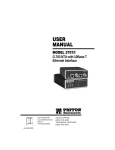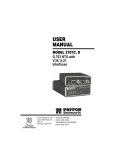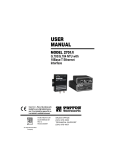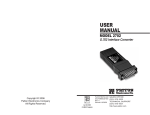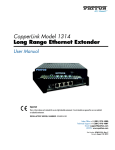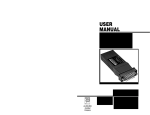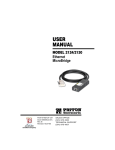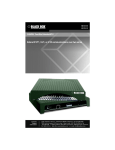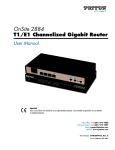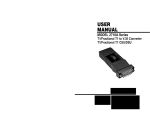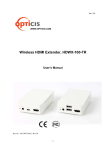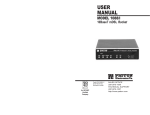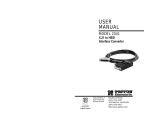Download Patton electronic MODEL 2707/I User's Manual
Transcript
USER MANUAL MODEL 2707/I G.703 NTU with 10Base-T Ethernet Interface Part# 07M2707I-UM Doc# 08625U2-001 Rev. C Revised 10/27/06 An ISO-9001 Certified Company SALES OFFICE (301) 975-1000 TECHNICAL SUPPORT (301) 975-1007 1.0 1.1 1.2 1.3 Warranty Information ................................................................. Radio and TV Interference............................................................ CE Notice...................................................................................... Service.......................................................................................... 4 4 4 4 2.0 2.1 2.2 General Information.................................................................... 6 Features........................................................................................ 6 Description.................................................................................... 6 3.0 3.1 PPP Operational Background.................................................... 7 Applications .................................................................................. 7 4.0 4.1 Configuration .............................................................................. 9 DIP Switch Configurations ............................................................ 9 Switch S1 settings ...................................................................... 10 SW1-1 Line Coding: HDB3 (default)........................................... 10 5.0 5.1 Installation................................................................................. 12 Connecting to the G.703 Network and Ethernet LAN ................. 12 Connecting Dual Coaxial Cable (75 ohm) to the G.703 Network 13 Connecting the Twisted Pair (120 ohm) to the G.703 Network .. 14 Connecting the 10Base-T Ethernet port to a PC (DTE) ............. 14 Connecting the 10Base-T Ethernet Port to a Hub ...................... 15 Power Connection ...................................................................... 15 Universal AC Power (100–240 VAC) .................................. 15 DC Power ............................................................................ 16 6.0 6.1 6.2 6.3 Operation................................................................................... Power-up .................................................................................... LED Status Monitors................................................................... Operating Line Loopback (LL) .................................................... 17 17 17 19 A A.1 A.2 A.3 A.4 A.5 A.6 A.7 G.703 Specifications................................................................. 20 Network Data Rate ...................................................................... 20 Network Connector ..................................................................... 20 Nominal Impedance ................................................................... 20 Line Coding ................................................................................ 20 Line Framing ............................................................................... 20 Clocking ...................................................................................... 20 Distance ...................................................................................... 20 B B.1 B.2 B.3 B.4 B.5 B.6 B.7 B.8 Ethernet 10Base-T Specifications........................................... 21 DTE Interface .............................................................................. 21 DTE Data Rates .......................................................................... 21 LAN Connection .......................................................................... 21 Protocol ....................................................................................... 21 MAC Address Table Size ............................................................ 21 MAC Address Aging ................................................................... 21 Frame Buffer ............................................................................... 21 Frame Latency ............................................................................ 21 2 B.9 B.10 B.11 B.12 B.13 B.14 B.15 Diagnostics ................................................................................. 21 Indicators .................................................................................... 21 Configuration .............................................................................. 21 Power Supply .............................................................................. 22 Humidity ...................................................................................... 22 Temperature ............................................................................... 22 Dimensions ................................................................................. 22 C Factory Replacement Parts and Accessories........................ 23 3 1.0 WARRANTY INFORMATION Patton Electronics warrants all Model 2707/I components to be free from defects, and will—at our option—repair or replace the product should it fail within one year from the first date of shipment. This warranty is limited to defects in workmanship or materials, and does not cover customer damage, abuse, or unauthorized modification. If this product fails or does not perform as warranted, your sole recourse shall be repair or replacement as described above. Under no condition shall Patton Electronics be liable for any damages incurred by the use of this product. These damages include, but are not limited to, the following: lost profits, lost savings and incidental or consequential damages arising from the use of or inability to use this product. Patton Electronics specifically disclaims all other warranties, expressed or implied, and the installation or use of this product shall be deemed an acceptance of these terms by the user. 1.1 RADIO AND TV INTERFERENCE The Model 2707/I generates and uses radio frequency energy, and if not installed and used properly—that is, in strict accordance with the manufacturer's instructions—may cause interference to radio and television reception. The Model 2707/I has been tested and found to comply with the limits for a Class A computing device in accordance with the specifications in Subpart B of Part 15 of FCC rules, which are designed to provide reasonable protection from such interference in a commercial installation. However, there is no guarantee that interference will not occur in a particular installation. If the Model 2707/I does cause interference to radio or television reception, which can be determined by disconnecting the cables, the user is encouraged to try to correct the interference by one or more of the following measures: moving the computing equipment away from the receiver, re-orienting the receiving antenna, and/or plugging the receiving equipment into a different AC outlet (such that the computing equipment and receiver are on different branches). 1.2 CE NOTICE The CE symbol on your Patton Electronics equipment indicates that it is in compliance with the Electromagnetic Compatibility (EMC) directive and the Low Voltage Directive (LVD) of the Union European (EU). A Certificate of Compliance is available by contacting Technical Support. 1.3 SERVICE All warranty and nonwarranty repairs must be returned freight prepaid and insured to Patton Electronics. All returns must have a Return Materi4 als Authorization number on the outside of the shipping container. This number may be obtained from Patton Electronics Technical Services at: • Tel: +1 (301) 975-1007 • Email: [email protected] • URL: http://www.patton.com Note Packages received without an RMA number will not be accepted. This device is not intended to be connected to the public telephone network. Caution 5 2.0 GENERAL INFORMATION Thank you for your purchase of this Patton Electronics product. This product has been thoroughly inspected and tested and is warranted for One Year parts and labor. If any questions or problems arise during installation or use of this product, please do not hesitate to contact Patton Electronics Technical Support at (301) 975-1007. 2.1 FEATURES • Terminates G.703 E1 service • Available in low-cost standalone or rack-mountable versions • 2.048 Mbps data rate • 10Base-T Ethernet bridge • PPP (Point to Point Protocol, RFC 1661) with Bridge Control Protocol (RFC 1638) • 75-ohm dual coax and 120-ohm twisted-pair G.703 connections • Line loopback diagnostics • Internal and G.703 network timing • CE marked • 100–240 VAC & 48 VDC power options • Conforms to ONP requirement CTR 12 for connection to international Telecom networks 2.2 DESCRIPTION The Model 2707/I receives clear channel E1/G.703 (2.048-Mbps) data from the telco's digital data network. The Model 2707/I terminates the G.703 telco interface and converts the data for transmission to a useroriented 10Base-T (802.3) Ethernet interface. The Ethernet (Model 2707/I) supports an integrated 10Base-T (802.3) Ethernet port with transparent bridging capability for IP, IPX, DECnet, NetBIOS and other layer-3 protocols. The 2707/I attaches to the LAN and intelligently bridges data traffic to the large central site router through the telco's leased line network. The 2707/I supports PPP (RFC 1661) and BCP (RFC 1638). The Model 2707/I is a 10Base-T bridge that operates over G.703 lines. It uses MAC learning and forwarding to provide seamless LAN-to-LAN connectivity. As a result, corporate enterprises can connect their servers to a pair of NTUs and automatically forward data packets that are meant for the remote network. Local packets are filtered and passed only to the local LAN. 6 3.0 PPP OPERATIONAL BACKGROUND PPP is a protocol used for multi-plexed transport over a point-to-point link. PPP operates on all full duplex media, and is a symmetric peer-topeer protocol, which can be divided into the following main components: • A standard method to encapsulate datagrams over serial links • A Link Control Protocol (LCP) to establish, configure, and test the data-link connection • A family of Network Control Protocols (NCPs) to establish and configure different network layer protocols In order to establish communications over a point-to-point link, each end of the PPP link must first announce its capabilities and agree on the parameters of the link’s operation. This exchange is facilitated through LCP Configure-Request packets. Once the link has been established and optional facilities have been negotiated, PPP will attempt to establish a network protocol. PPP will use Network Control Protocol (NCP) to choose and configure one or more network layer protocols. Once each of the network layer protocols have been configured, datagrams from the established network layer protocol can be sent over the link. The link will remain configured for these communications until explicit LCP or NCP packets close the link down, or until some external event occurs. The PPP Bridging Control Protocol (BCP), defined in RFC 1638, configures and enables/disables the bridge protocol on both ends of the pointto-point link. BCP uses the same packet exchange mechanism as the Link Control Protocol (LCP). BCP is a Network Control Protocol of PPP, bridge packets may not be exchanged until PPP has reached the network layer protocol phase. 3.1 APPLICATIONS In situations where a routed network requires connectivity to a remote Ethernet network, the interface on a router can be configured as a PPP IP Half Bridge. The WAN line to the remote bridge functions as a Virtual Ethernet interface, effectively extending the routers WAN port connection to the remote network. The bridge device sends bridge packets (BPDU’s) to the router’s WAN interface. The router will receive the layer three address information and will forward these packets based on its IP address. 7 Model 2707/I Model 2707/C Router E1 Internet Ethernet LAN Customer’s Site Service Provider’s Network Figure 1. Cisco router with serial interface, configured as PPP Half Bridge. Figure 1 shows a typical Cisco router with a serial interface configured as a PPP Half Bridge. The router serial interface connects to the WAN via a 2707/C (V.35) E1 NTU and to the remote 2707/I with support for PPP bridging. The 2707/I functions as a node on the remote Ethernet network. The serial interface on the Cisco will have an IP address on the same Ethernet subnet as the bridge. For example, the customer site is assigned the addresses 192.168.1.0/ 24 through 192.168.1.1/24. The address 192.168.1.1/24 is also the default gateway for the remote network. The above settings remove any routing/forwarding intelligence from the 2707/I. The associated Cisco configuration will set serial interface (s0) to accommodate half bridging for the above example. ! interface s0 ppp bridge ip ip address 192.168.1.1 255.255.255.0 ! Authentication is optional under PPP. In a point-to-point leased-line link, incoming customer facilities are usually fixed in nature, therefore authentication is generally not required. Some networking systems do not define network numbers in packets sent out over a network. If a packet does not have a specific destination network number, a router will assume that the packet is set up for the local segment and will not forward it to any other sub-network. However, in cases where two devices need to communicate over the wide-area, bridging can be used to transport non-routable protocols. 8 4.0 CONFIGURATION The Model 2707/I features configuration capability via hardware DIP switches. This section describes all possible DIP switch configurations of the Model 2707/I. 4.1 DIP SWITCH CONFIGURATIONS The Model 2707/I has an internal DIP switch that enables configuration for a wide range of applications. The DIP switch is accessed from the underside. Figure 2 shows the location of the DIP switches on the bottom of the printed circuit board. Front S1 Rear Figure 2. Underside of Model 2707/I, showing location of DIP switches The DIP switches can be configured as either “ON” or “OFF”. Figure 3 shows the orientation of the DIP switches with respect to ON/OFF positions. ON ON DHS-8 1 2 3 4 5 6 7 8 OFF OFF Figure 3. Close-up view of configuration switches 9 Switch S1 settings Table 1 shows the settings for DIP switch S1-1 thru S1-8. Table 1: Switch S1 settings Switch Description S1-1 Line Coding S1-2 Line Loopback (toward E1 line) Setting Off = HDB3 On = AMI Off = LLB disabled On = LLB enabled Note The Model 2707/I, when in line loopback mode, will loop the network line and return any trafic received on the E1 line to the sending device at the remote end. S1-3 S1-4 S1-5 S1-6/S1-7 S1-8 Reserved Reserved Reserved Clocking Off = Default Off = Default Off = Default Switch Switch 1-6 1-7 On On Network On Off Internal (default) Off On Reserved Off Off Off = Default Reserved Network SW1-1 Line Coding: HDB3 (default) Use Switch SW1-1 to control the Network Line Coding options. Set these options to be the same as the Line Coding given to you by your Service Provider. If you are using two Model 2707/Is together as short range modems, set both units to HDB3. SW1-1 Line Encoding Off On HDB3 AMI Options: HDB3, AMI • HDB3. In this line coding, the transmitter substitutes a deliberate bipolar violation when excessive zeros in the data stream are detected. 10 The receiver recognizes these special violations and decodes them as zeros. This method enables the network to meet minimum pulse density requirements. Unless AMI is required in your application, HDB3 should be used whenever possible. • AMI. Alternate Mark Inversion defines a pulse as a "mark,” a binary one, as opposed to a zero. In an E1 network connection, signals are transmitted as a sequence of ones and zeros. Ones are sent as pulses, and zeros are sent as spaces, i.e., no pulse. Every other pulse is inverted from the previous pulse in polarity, so that the signal can be effectively transmitted. This means, however, that a long sequence of zeros in the data stream will cause problems, since the NTU receiving the signal relies on the signal to recover the 2.048 Mbps clock. Note If you must use AMI, you should ensure that the data terminal equipment connected to the unit provides a minimally acceptable pulse density. For this reason, there are advantages to using HDB3 instead. AMI coding does not inherently account for ones density. To meet this requirement, the user should ensure that the data inherently meets pulse density requirements. 11 5.0 INSTALLATION Once the Model 2707/I is properly configured, it is ready to connect to the G.703 interface, to the Ethernet port, and to the power source. This section describes how to make these connections. 5.1 CONNECTING TO THE G.703 NETWORK AND ETHERNET LAN This section describes installing the G.703 (75-ohm and 120-ohm), Ethernet LAN, and power connections (shown in Figure 4). Refer to the following to detemine which installation procedures you will use: • The 75-ohm dual-coax female BNCs (TXand RX) are used for connecting to a 75-ohm dual coax G.703 network interface. If your G.703 network terminates via dual coaxial cables, refer to section “Connecting Dual Coaxial Cable (75 ohm) to the G.703 Network” on page 13 • The 120-ohm RJ-48C jack is used for connecting to a 120-ohm twisted-pair G.703 network interface. If your G.703 network terminates with a RJ-48C, refer to section “Connecting the Twisted Pair (120 ohm) to the G.703 Network” on page 14. • The Ethernet 10Base-T port is configured as DTE (Data Terminal Equipment). If the Model 2707/I is to connect to another DTE device such as a 10Base-T network interface card in a PC, refer to “Connecting the 10Base-T Ethernet port to a PC (DTE)” on page 14. Otherwise, refer to “Connecting the 10Base-T Ethernet Port to a Hub” on page 15. • Refer to “Power Connection” on page 15 to connect the Model 2707/I to a 100–240 VAC source or to a 36–60 VDC DC-to-DC adapter. Power Ethernet 75 ohm 120 ohm TX Figure 4. Model 2707/I rear panel 12 75 ohm RX Connecting Dual Coaxial Cable (75 ohm) to the G.703 Network Refer to Figure 5 to make the proper connections. DataTO Network TX RX Data FROM Network Figure 5. Rear panel, showing location of connectors Note The outer conductor of the coax cables are isolated from system earth ground. When using the 75-ohm interface, jumper straps JP2, JP5, JP6, and JP7 must be installed over the jumpers. The jumpers are located next to the BNC connectors. Do the following to configure the jumpers: 1. Open the case by inserting a screwdriver into the slots and twist the screwdriver head slightly. The top half of the case will separate from the lower half of the case. Take caution not to damage any of the PC board mounted components 2. Open the case and install jumper straps for JP2, JP5, JP6, and JP7. 13 Connecting the Twisted Pair (120 ohm) to the G.703 Network Refer to the pinout and signals chart in Figure 6 to connect the 120-ohm G.703 network channel. NETWORK SIGNAL SIGNAL PIN# RX(R) RX(T) TX(R) TX(T) 4 5 TX(R) TX(T) RX(R) RX(T) 1 2 Shield Shield Shield Shield 3 6 RJ-48C Jack Signal Name 1 2 3 4 5 6 7 8 1 2 3 4 5 6 7 8 (RX) Receive (Ring) (RX) Receive (Tip) Shield (TX) Transmit (Ring) (TX) Transmit (Tip) Shield No connection No connection Figure 6. G.703 120-ohm connection. Connecting the 10Base-T Ethernet port to a PC (DTE) To connect the Model 2707/I to another DTE device such as a 10Base-T network interface card, construct a 10Base-T crossover cable and connect the wires as shown in Figure 7 below and Figure 8 on page 15. 1 2 3 4 5 6 7 8 1 TD+ (data output from 2707/I) 2 TD- (data output from 2707/I) 3 RD+ (data input to 2707/I) 4 (no connection) 5 (no connection) 6 RD- (data input to 2707/I) 7 (no connection) 8 (no connection) Figure 7. Connecting the 10Base-T Ethernet Port to a PC 14 10Base-T DTE RJ-45 Pin No. 1 (TD+) 2 (TD-) 10Base-T Port RJ-45 Pin No. 1 (TD+) 2 (TD-) 3 (RD+) 6 (RD-) 3 (RD+) 6 (RD-) Figure 8. 10Base-T cross-over cable connection Connecting the 10Base-T Ethernet Port to a Hub The 10Base-T interface is configured as DTE (data terminal equipment), just like a 10Base-T network interface card in a PC. Therefore, it “expects” to connect to a 10Base-T Hub using a straight-through RJ-45 cable. Refer to Figure 9 below and Figure 7 on page 14 to construct a cable to connect the 10 Base-T interface to a 10Base-T hub. 10Base-T Hub RJ-45 Pin No. 1 (RD+) 2 (RD-) 10Base-T Port RJ-45 Pin No. 1 (TD+) 2 (TD-) 3 (RD+) 6 (RD-) 3 (TD+) 6 (TD-) Figure 9. Connecting the 10Base-T Ethernet port to a hub Power Connection Universal AC Power (100–240 VAC). The Model 2707/I uses a 5VDC, 2A universal input 100-240VAC, power supply (center pin is +5V). The universal input power supply has a male IEC-320 power entry connector. This power supply connects to the Model 2707/I by means of a barrel jack on the rear panel. Many international power cords are available for the universal power supply. Note The Model 2707/I powers up as soon as it is plugged into an AC outlet—there is no power switch. 15 DC Power. The 36-60 VDC DC to DC adapter is supplied with the DC version of the Model 2707/I. The black and red leads plug into a DC source (nominal 48VDC) and the barrel power connector plugs into the barrel power supply jack on the 2707/I. (See Figure 10). 1.0A 0.2A MAX SWITCHING POWER SUPPLY INPUT : 36-60V MODEL : SYD1106-0505 OUTPUT : +5V MADE IN CHINA BY SUNNY S/N: G01234567890 Barrel power connector OUTPUT POWER : 5W MAX To Power Supply Jack -Vin To -48VDC Source Black lead (-V) Red lead (+V) +Vin Figure 10. Connecting DC power to the 2707/I DC power supply 16 6.0 OPERATION When the Model 2707/I has been properly configured and installed, it should operate transparently. This section describes power-up, LED status monitors, and the built-in loopback test modes. 6.1 POWER-UP Before applying power to the Model 2707/I, please review section “Power Connection” on page 15 to verify that the unit is properly connected to the appropriate power source. 6.2 LED STATUS MONITORS The Model 2707/I features six front panel LEDs that monitor connections on the G.703 and 10Base-T links, signaling, error and test modes. Figure 11 shows the front panel location of each LED. Table 2 on page 18 lists descriptions of each LED. 10Base-T Figure 11. 2707/I front panel 17 Table 2: LED descriptions LED E1 Link 10BT Link Status Description (Active Green) Solid green (On) indicates that the end to end E1 Link is up, signifying that the link is active. The E1 Link LED is Off when the link is down. (Active Green) Solid green indicates that the 10Base-T Ethernet interface has detected a valid SQE heartbeat, signifying a valid 10Base-T connection. Blinks yellow from one to eleven times to indicate system status. Each pulse pattern is separated by a 2 second “off” period. Greater pulse patterns have higher priority (buffer saturation has greater priority than an empty MAC table). Valid system statuses are: 1 pulse—system status is okay 2 pulses —no MAC entries in the MAC Address Table 3 pulses—Clear to Send (CTS) or Carrier Detect (DCD) from base unit are not asserted 4 pulses—IM1/I buffer is saturated 5 pulses —WAN receive frame(s) too large 6 pulses —WAN receive frame(s) not octet aligned 7 pulses—WAN receive frame(s) aborted 8 pulses—Detected WAN receive frame(s) with CRC 9 pulses—Detected LAN receive frame(s) too large 10 pulses—Detected LAN receive frame(s) not octet aligned TM 11 pulses—Detected LAN receive frame(s) with bad CRC (Active Yellow) Solid Yellow indicates an Active Test Mode. 18 6.3 OPERATING LINE LOOPBACK (LL) The Line Loopback (LL) test checks the operation of the local Model 2707/I, and is performed separately on each unit. G.703 NTU Model 2707/I 2 Mbps G.703 Network Clock/ Data Network Clocking Ethernet Device Cable Span Data Clock/ Data Model 2707/I Figure 12. Line loopback for a network termination application To perform an LL test, set DIP switch S1-2 to On. The TM LED will be lit while the unit is in loopback test mode. 19 APPENDIX A G.703 SPECIFICATIONS A.1 NETWORK DATA RATE 2.048 Mbps A.2 NETWORK CONNECTOR RJ-48C/Dual Coax BNC A.3 NOMINAL IMPEDANCE 75/120 ohm A.4 LINE CODING Selectable AMI or HDB3 A.5 LINE FRAMING G.703 (Unframed) A.6 CLOCKING Internal or Network (Receive Recover) A.7 DISTANCE Maximum 6,000 ft (1.6 km) On 24 AWG cable 20 APPENDIX B ETHERNET 10BASE-T SPECIFICATIONS B.1 DTE INTERFACE 10Base-T on RJ-45F B.2 DTE DATA RATES 10 Mbps B.3 LAN CONNECTION RJ-45, 10Base-T, 802.3 Ethernet B.4 PROTOCOL PPP (RFC 1661) with Bridging Control (RFC 1638) B.5 MAC ADDRESS TABLE SIZE 4096 entries B.6 MAC ADDRESS AGING MAC addresses deleted after 8 minutes of inactivity B.7 FRAME BUFFER 512 Frames B.8 FRAME LATENCY 1 frame B.9 DIAGNOSTICS Line Loopback B.10 INDICATORS E-1 Link, 10Base-T Link, Ethernet Status, Test Mode B.11 CONFIGURATION 8-Position DIP Switch 21 B.12 POWER SUPPLY 5 VDC external power supply 100–240VAC, 50–60Hz, 0.4A B.13 HUMIDITY Up to 90% non-condensing B.14 TEMPERATURE 0–50°C (32–122°F) B.15 DIMENSIONS 3.5L x 2.1W x 0.78H in.(9.0L x 5.3W x 2.0H cm) 22 APPENDIX C FACTORY REPLACEMENT PARTS AND ACCESSORIES Patton Model # Description 2707/C 2707/D 2707/I 08055DCUI 07M2707/I G.703 NTU with a V.35 interface G.703 NTU with an X.21 interface G.7034 NTU with 10Base-T ethernet interface Universal Input Power Supply User Manual 23 Copyright © 2006 Patton Electronics Company All Rights Reserved. 24
























